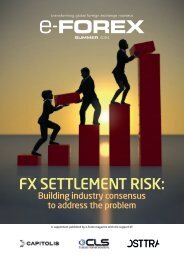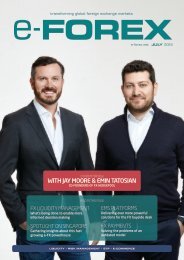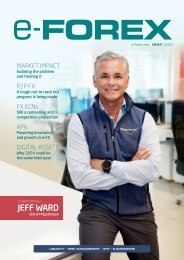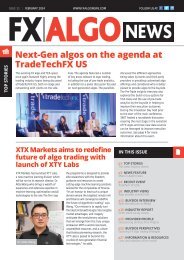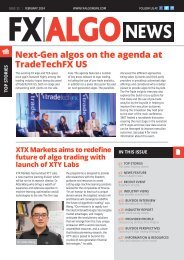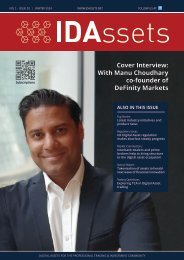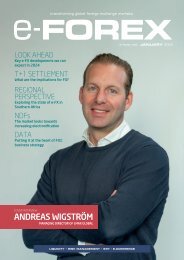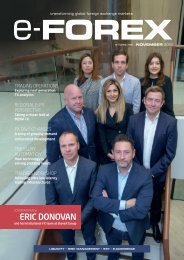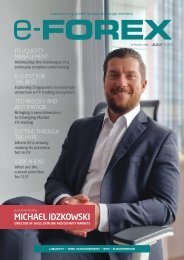Create successful ePaper yourself
Turn your PDF publications into a flip-book with our unique Google optimized e-Paper software.
Electronification rising amid turbulence: Taking a closer look at the MENA FX picture<br />
REGIONAL E-FX PERSPECTIVE<br />
“Like elsewhere, the buyside across the MENA region is<br />
eager to understand trade costs and what their impact is on<br />
the market and how their liquidity will be used.”<br />
Albert Blackburn<br />
HSBC’s Almohri agrees. “Local banks<br />
are adapting to electronification at<br />
pace,” he says. “It’s a strong trend<br />
that we do not see slowing down<br />
anytime soon. This has involved material<br />
changes in workflow, processes, and<br />
technological buildout, which, as one<br />
might expect, can carry operational<br />
risks in their execution and, therefore,<br />
might require adjustment in planning<br />
timelines.”<br />
Blackburn notes that LSEG doesn’t view<br />
the region as an emerging market, as is<br />
the prevalent global view. Several GCC<br />
countries only recently moved from<br />
the MSCI Frontier Markets index to the<br />
Emerging Markets one. While this move<br />
has accelerated FDI inflows, volumes<br />
remain small compared to global<br />
benchmarks.<br />
He explains further. “Many of the<br />
regional firms have been engaged<br />
in electronic trading in the global<br />
FX market for many years,” he says.<br />
“Whilst there are opportunities to<br />
support governments and central banks<br />
evolve market structure as countries<br />
look to reform access to their domestic<br />
currencies, we see no difference in the<br />
levels of client sophistication in this<br />
region to any other.”<br />
DEMAND FROM SOPHISTICATED<br />
INVESTORS<br />
Regulation and continued government<br />
investment in infrastructure are slowly<br />
turning the GCC into a hub for<br />
sophisticated investors. Almohri lists a<br />
few reasons for several hedge funds<br />
and asset managers setting up shop<br />
here.<br />
“Exponential growth in the region’s<br />
debt capital markets, following the oil<br />
Many asset managers and hedge funds have moved their physical locations to MENA, to capitalise on the economic<br />
growth of the region<br />
price drops between 2014 to 2016,<br />
together with the transformation<br />
and economic diversification plans in<br />
MENA, has attracted a large number<br />
of hedge funds and asset managers<br />
into the region,” he says. “With that,<br />
we have observed a higher interest<br />
in methods of execution and data<br />
analytics, which are tailored for a more<br />
sophisticated segment of the market.”<br />
“We have observed more demand and<br />
FX flow driven by foreign investors,”<br />
he continues. “This has been in<br />
response to policy changes leading to<br />
a relaxation of restrictions on foreign<br />
ownership of assets and allowing more<br />
access to the market.”<br />
As electronification steadily rises, algo<br />
adoption is also increasing. “FX algo<br />
execution is still at an early stage of<br />
adoption in MENA,” cautions Almohri,<br />
“although it is becoming a growing<br />
topic of discussion with clients as<br />
an additional tool at their disposal,<br />
particularly among institutions that<br />
trade equities. Algorithmic stock<br />
executions are more mature and<br />
already embedded in their typical<br />
workflow.”<br />
And what does the electronic versus<br />
voice trading picture look like? Some<br />
MENA currencies are famously illiquid.<br />
Has electronification changed that<br />
picture? Blackburn and Almohri reckon<br />
it hasn’t. “Electronic markets are<br />
now the norm in more established<br />
and larger Middle East economies,”<br />
Blackburn says, “however in smaller<br />
markets, central banks are seeking to<br />
work with their local counterparties<br />
to facilitate orderly markets. In some<br />
regions e-trading is still relatively new,<br />
continued pressures on credit and<br />
banks are facilitating this approach.”<br />
“Voice trading is still the preferred<br />
channel for large transactions,” Almohri<br />
says, “where electronic liquidity<br />
doesn’t exist or is particularly thin. One<br />
significant factor for further increasing<br />
electronic liquidity distribution would<br />
36 NOVEMBER 20<strong>23</strong> e-FOREX




